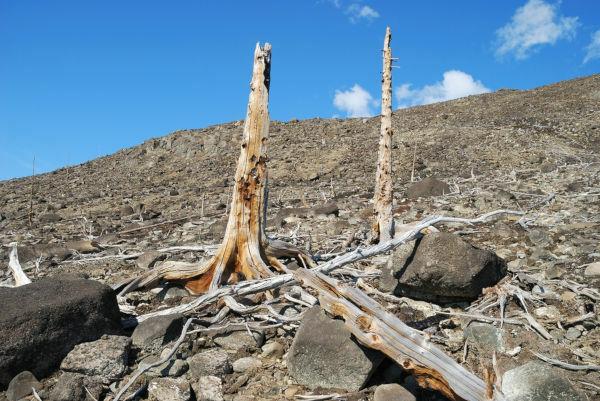THE acid rain it is a typical environmental problem in industrialized and developing countries such as Brazil, Mexico, China. Represents rainfall or any forms of precipitation that present high acid concentrations. For geography, acid rain is considered to be that which presents a pH below the tolerable level of approximately 5.5.
Read too: types of rain
Acidity of rain
The acidity of a solution can be measured using a numerical scale known as pH. According to this scale, pH 7 indicates neutrality. Thus, the lower the pH, the more acidic the solution will be. On the other hand, the higher the pH, the more alkaline it will be.
Every rain has a little acidity, as there are natural oxides in the air. Normally, the pH of a rain considered "normal" is around 5.6. Tap water has a pH of 6.8, and pure water has a pH close to or equal to 7. To be considered acidic, rain must have pH less than 5.5.
Origin of acid rain
Acid rain can have natural or anthropogenic origins:
1. Natural:volcanoes are natural agents that favor the formation of acid rain, as they release gases, particles and sulfur and dust compounds into the atmosphere. Biological processes that take place in soil, swamps and oceans are also agents that can trigger acid rain.
2. Anthropogenic action:industrial activities, burning of fossil fuels by transport, factories and thermoelectric plants emit large amounts of polluting gases into the atmosphere, which can trigger the formation of rain acidic.
Composition of acid rain
Acid rain is composed of concentrated acids such as sulfur oxides, carbon oxides, nitrogen oxides and sulfur dioxides. These oxides react with water to form acids. The strongest acid that makes up acid rain is sulfuric acid, formed by the reaction between sulfur oxides and water.
See the table below for the origin of some gases that make up acid rain:
polluting gas |
Origin |
sulfur dioxide |
- Coal combustion - Manufacture of fertilizers - Heating of sulphate group ores |
Nitrogen oxides |
- Combustion of charcoal - Combustion of petroleum products - cigarette smoke |
Hydrochloric acid |
- Fertilizer industries - Electrochemical industries - Combustion of materials composed of chlorine |
Hydrofluoric acid |
- Glass industries - Heavy metal foundries - Fertilizer industries |
How is acid rain formed?

The gases released into the atmosphere by the industries react and are diluted in water, forming acid rain.
Gases emitted to the atmosphere, such as sulfur oxide, react with water and form sulfuric and sulphurous acids. The reaction of nitrogen gas with water forms nitric and nitrous acids. These are the main acids that make up acid rain.
The precipitation of acid rain causes countless damages to the environment and to living beings. It is worth remembering that winds can carry polluting gases to regions far from the source that the emitted, causing acid rain to occur not only in emission sites, but also in regions away.
Know more:How do rains form?
consequences of acid rain
Acid rain is considered a serious problem worldwide. As a result of the increase in air pollution, associated with the emissions of polluting gases by natural agents, the incidence of acid rain has intensified in all parts of the planet, especially in countries industrialized.
Precipitation with acid concentration can cause soil damage, making them acidified. Soil contamination can reach water resources such as groundwater, rivers and lakes. Low pH water causes loss of biodiversity, making the development of aquatic life impossible.
Vegetation is also affected by acid rain. Studies indicate that acidity harms plant development, causing them to show slow growth, and may even die. The surface of the leaves is broken, causing their nutritional impoverishment and making the vegetation susceptible to diseases and pests. In addition, the roots grow slowly, making it difficult to transport nutrients. Acid rain can also affect crops, harming crops and causing several social and economic losses.

Acid rain also affects the health of human beings. The accumulation of sulfur dioxide in the body can cause respiratory diseases. In addition, drinking acidified water can cause diseases such as Alzheimer's, Parkinson's and hypertension. In children, problems associated with the brain can occur.
The environment is also harmed by acid precipitation. Monuments and civil works may suffer corrosion and be destroyed.

One of the consequences of acid rain is the corrosion of monuments and civil works.
Acid rain in Brazil
Acid rain is an atmospheric phenomenon already registered in parts of Brazil. The most striking example was the case that occurred in the Serra do Mar region, in Cubatão, São Paulo, in 1977. In this region, gases emitted by industries, such as carbon monoxide, sulfur dioxide and benzene, exceeded one thousand tons per day.
The recurrent acid rain at the site was extremely harmful to the Atlantic forest, destroying much of its vegetation. Due to the great destruction caused, there are several reforestation programs in Cubatão in order to protect the slopes that have lost their vegetation cover. The city's population has also suffered the consequences of this phenomenon, with high rates of disease respiratory diseases and births of many children with anencephaly and other malformations in the system nervous.
Take the opportunity to check out our video lesson on the subject:


